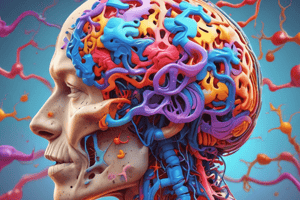Podcast
Questions and Answers
What is the primary area affected in individuals with Gerstmann's syndrome?
What is the primary area affected in individuals with Gerstmann's syndrome?
- Broca's area
- Area 39
- Area 3,1,2
- Parietal lobe (angular gyrus) (correct)
Which type of aphasia is characterized by a severe impairment in all aspects of language comprehension and production?
Which type of aphasia is characterized by a severe impairment in all aspects of language comprehension and production?
- Global aphasia (correct)
- Broca's aphasia
- Wernicke's aphasia
- Anomic aphasia
Which area of the brain is responsible for language processing and is affected in individuals with aphasia?
Which area of the brain is responsible for language processing and is affected in individuals with aphasia?
- Primary somatosensory cortex
- Primary visual cortex
- Broca's and Wernicke's areas (correct)
- Parietal lobe
What is the primary symptom of ideational apraxia?
What is the primary symptom of ideational apraxia?
Which area of the brain is affected in individuals with hemianesthesia?
Which area of the brain is affected in individuals with hemianesthesia?
What is the primary symptom of hemispatial neglect?
What is the primary symptom of hemispatial neglect?
Which area of the brain is responsible for motor control and is affected in individuals with hemiplegia?
Which area of the brain is responsible for motor control and is affected in individuals with hemiplegia?
What is the primary symptom of hemiballismus?
What is the primary symptom of hemiballismus?
Which area of the brain is affected in individuals with dysphagia?
Which area of the brain is affected in individuals with dysphagia?
Which area of the brain is affected in individuals with hemianopsia?
Which area of the brain is affected in individuals with hemianopsia?
Study Notes
Aphasia and Apraxia
- Conduction aphasia: difficulty repeating words and sentences despite understanding language, associated with lesions in the arcuate fasciculus.
- Constructional apraxia: difficulty in drawing or assembling objects, associated with lesions in the parietal lobe.
- Disconnection apraxia: difficulty in tasks that require coordination between different parts of the body, associated with lesions in the corpus callosum.
- Dressing apraxia: difficulty in dressing oneself due to an inability to sequence and coordinate movements, associated with lesions in the parietal lobe, right hemisphere.
- Apraxia: inability to perform tasks or movements when asked, associated with lesions in the area 6 premotor area and frontal and parietal lobes.
Visual and Sensory Disorders
- Cortical blindness: partial or complete loss of vision due to damage to the brain's visual cortex, despite the eyes being physically healthy, associated with bilateral lesions of the primary visual cortex.
- Dyschromatopsia: difficulty in perceiving colors, often resulting from damage to the brain's visual processing centers, associated with lesions in the occipital lobe, particularly the fusiform gyrus.
- Hemianesthesia: loss of sensation on one side of the body, associated with lesions in the parietal lobe.
- Hemianopsia: loss of half of the visual field in one or both eyes, associated with lesions in the occipital lobe (primary visual cortex).
Language Disorders
- Alexia: inability to read, associated with lesions in the left occipital lobe and splenium of corpus callosum.
- Anomia: difficulty in naming an object or person, associated with lesions in the left temporal lobe.
- Aprosody: difficulty expressing or understanding the emotional tone of speech, associated with lesions in the area 44 Broca's Area and right hemisphere, particularly right frontal lobe.
Other Neurological Disorders
- Anosognosia: unawareness of one's own illness or disability, associated with lesions in the area 40 Broca's Area and parietal lobe, often right hemisphere.
- Apathy: lack of interest, enthusiasm, or concern about things that usually interest or excite others, associated with lesions in the prefrontal cortex, particularly medial prefrontal cortex (mPFC).
- Athetosis: involuntary, slow, writhing movements, typically affecting the hands, feet, and sometimes the face, associated with lesions in the globus pallidus and basal ganglia.
- Dysphagia: difficulty swallowing, associated with lesions in the area 3, 1, 2 (primary somatosensory cortex) and brainstem or cortical areas involved in motor control.
- Gerstmann's syndrome: neurological condition characterized by a combination of symptoms including difficulty with writing, associated with lesions in the area 39 and left parietal lobe - angular gyrus.
- Global aphasia: severe impairment in all aspects of language comprehension and production, associated with large lesions affecting both Broca's and Wernicke's area and surrounding regions.
- Hemiballismus: involuntary, violent, and flinging movements of one side of the body, associated with lesions in the subthalamic nucleus.
- Hemiplegia: paralysis of one side of the body, associated with lesions in the motor cortex.
- Hemispatial neglect: inattention to one side of space, typically after damage to the right parietal lobe of the brain.
- Ideational apraxia: difficulty in conceptualizing or planning a sequence of coordinated movements required to perform a task, associated with lesions in the parietal lobe.
Studying That Suits You
Use AI to generate personalized quizzes and flashcards to suit your learning preferences.
Related Documents
Description
This quiz covers different types of aphasia and apraxia, including conduction aphasia, constructional apraxia, disconnection apraxia, and dressing apraxia. Learn about the symptoms and associated brain lesions of these neurological disorders.



